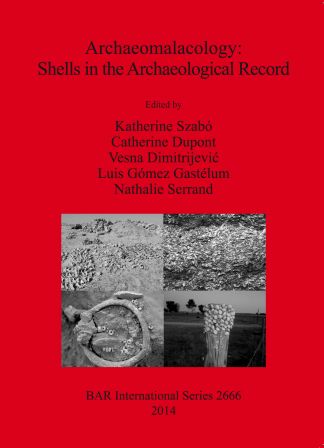Szabó K., Dupont C., Dimitrijevic V., Gastélum Gómez L. G., Serrand N., (eds.), 2014- Archaeomalacology: Shells in the Archaeological Record. Proceedings of the 11th ICAZ International Conference. Paris - Archaeomalacology Working group, 23-28 August 2010
Par Catherine Dupont le samedi 22 novembre 2014, 10:43 - Zoom sur publications - Lien permanent

Summary
This publication is the volume of the ICAZ Archaeomalacology Working group of the proceedings of the 11th International Conference of the International Council for Archaeozoology (ICAZ), which was held in Paris (France) 23rd-28th August 2010. Twenty-three papers are published with evidences of human collection and modification of shells from all over the world and at a large scale of chronology (from Prehistory to Antiquity). The papers are organized in three sub-sessions. The section “Acquisition and use of shell raw materials in prehistory” focuses on patterns of acquisition and use of shell raw materials as well as on the production sequences of shell items in time and space. Specific themes of interest include the exploitation of shells as raw materials in relation to their dietary functions, or choices made to use particular shells along with or as opposed to other raw materials.
The section “Shell middens and shells as a food resource” provides a venue to explore the relationships between human groups and molluscan resources and especially encourages the combination of information derived from multiple disciplines, as well as studies that seek to contextualise shell-gathering in a wider socio-economic context. The section “Shells as indicators of palaeoenvironment, site formation and transformation” aims to investigate the potential of archaeological shell to answer questions not directly related to subsistence or material culture and especially welcomes contributions which mobilise the study of archaeological shell in relation to modern resource management and environmental change.
Contents
Editors of the volume
Katherine Szabó, Catherine Dupont, Vesna Dimitrijević, Luis Gómez Gastélum and Nathalie Serrand
Preface
Jean-Denis Vigne, Christine Lefèvre and Marylène Patou-Mathis
Introduction
Acquisition and use of shell raw materials in prehistory
1. The use of marine mollusc shells at the Neolithic site Shkarat Msaied, Jordan
Aiysha Abu-Laban
2. Evaluating the role of molluscan shells assemblage recovered from Padri, a coastal Harappan settlement in Gujarat, India
Arati Deshpande-Mukherjee and Vasant Shinde
3. The provenance and use of fossil scaphopod shells at the Late Neolithic/Eneolithic site Vinča – Belo Brdo, Serbia
Vesna Dimitrijević
4. Perforated shells from an Early Mesolithic cemetery at La Vergne (Charente-Maritime, France): from acquisition to use and (sometimes) to wear
Catherine Dupont, Luc Laporte, Patrice Courtaud, Henri Duday and Yves Gruet
5. Shell use in West Mexico and the Southwestern United States. An archaeological comparison
Luis Gómez Gastélum
6. Occurences of exogenous freshwater mussel shells (Bivalvia: Unionida) during the precolumbian ceramic age of the lesser Antilles
Nathalie Serrand and Kevin S. Cummings
7. Dead from the sea: worn shells in Aegean prehistory
Tatiana Theodoropoulou
8. Temporal changes in shell bead technologies based on Levantine examples
Daniella E. Bar-Yosef Mayer
9. Shell tools in an early Neolithic coastal site in the Cantabrian region (Northern Spain): an experimental program for use-wear analysis at Santimamiñe cave
David Cuenca-Solana, Igor Gutiérrez-Zugasti and Ignacio Clemente
Shell middens and shells as a food resource
10. Shell Middens and the use of molluscs in the Late Middle Holocene in the Rio de la Plata: an ethnoarchaeological contribution
Laura Beovide
11. Marine Resource Exploitation at Mersa/Wadi Gawasis (Red Sea, Egypt). The Harbour of the Pharaohs to the Land of Punt
Alfredo Carannante, Rodolfo Fattovich and Carla Pepe
12. Shellfish gathering during the Iron Age and Roman times in the Northwest of the Iberian Peninsula
Carlos Fernández-Rodríguez, Víctor Bejega-García and Eduardo González-Gómez-de-Agüero
13. Shellfishing and Horticulture in Prehistoric Northern New Zealand
Tiffany James-Lee
14. Fisher-Gatherers of the Red Sea: Results of the Farasan Archipelago Shell Sites Project
Matt Gregory Meredith Williams
15. Shell exploitation at Playa del Tesoro and Banderas Mexican Pacific coast
José Beltrán
16. Oysters, Pheasants and Fine Foods. “High Class” Products in Alife (Campania, Italy) during and after the Roman Empire.
Alfredo Carannante, Salvatore Chilardi, Daniela Rebbecchi, Annalisa Del Santo, Roberto Vedovelli
17. Archaeozoological analysis of molluscan fauna from the Late Bronze Age stratum of site 4 of Tell Jenin (Northern West Bank, Palestine)
Ademar Ezzughayyar, Khalid M. Swaileh
18. Acquisition and management of marine invertebrates resources on a pre-Roman coastal settlement : the site of Dossen Rouz (Locquémeau-Trédrez, Brittany, France)
Caroline Mougne, Catherine Dupont, Anna Baudry, Laurent Quesnel and Marie-Yvane Daire
Shells as indicators of palaeoenvironment, site formation and transformation
19. Dynamics of palaeoenvironmental conditions over the last millennia by archaeomalacological data (on example of ADK-009 shell midden, Adak Island, Aleutian Islands)
Zhanna Antipushina
20. Biostratigraphy of shells and climate changes in the Cantabrian region (Northern Spain) during the Pleistocene-Holocene transition
Igor Gutiérrez-Zugasti and David Cuenca-Solana
21. Deposits of terrestrial snails: Natural or Anthropogenic processes?
Eloísa Bernáldez-Sánchez and Esteban García-Viñas
22. Micro-Freshwater Gastropod Remains from Çatalhöyük, Turkey: Preliminary Environmental Observations
Burçin Aşkım Gümüs and, Daniella E. Bar-Yosef Mayer
23. Mollusc Shells from Archaeological Building Materials
Matt Law
Commentaires